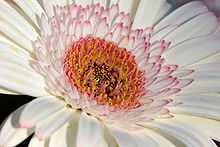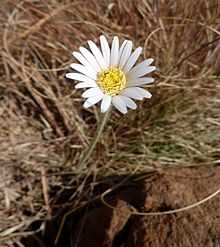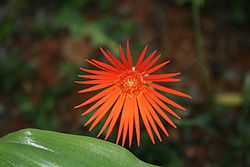Gerbera
| Gerbera | |
|---|---|
 | |
| Close up of a white gerbera | |
| Scientific classification | |
| Kingdom: | Plantae |
| (unranked): | Angiosperms |
| (unranked): | Eudicots |
| (unranked): | Asterids |
| Order: | Asterales |
| Family: | Asteraceae |
| Subfamily: | Mutisioideae |
| Tribe: | Mutisieae |
| Genus: | Gerbera L. |


Gerbera (/ˈdʒɜrbərə/ or /ˈɡɜrbərə/) L. is a genus of ornamental plants from the sunflower family (Asteraceae). It was named in honour of the German botanist and naturalist Traugott Gerber († 1743) who travelled extensively in Russia and was a friend of Carolus Linnaeus.[1]
It has approximately 30 species in the wild, extending to South America, Africa and tropical Asia. The first scientific description of a Gerbera was made by J.D. Hooker in Curtis's Botanical Magazine in 1889 when he described Gerbera jamesonii, a South African species also known as Transvaal daisy or Barberton Daisy. Gerbera is also commonly known as the African Daisy.
Gerbera species bear a large capitulum with striking, two-lipped ray florets in yellow, orange, white, pink or red colours. The capitulum, which has the appearance of a single flower, is actually composed of hundreds of individual flowers. The morphology of the flowers varies depending on their position in the capitulum. The flower heads can be as small as 7 cm (Gerbera mini 'Harley') in diameter or up to 12 cm (Gerbera ‘Golden Serena’).
Gerbera is very popular and widely used as a decorative garden plant or as cut flowers. The domesticated cultivars are mostly a result of a cross between Gerbera jamesonii and another South African species Gerbera viridifolia.[2] The cross is known as Gerbera hybrida. Thousands of cultivars exist. They vary greatly in shape and size. Colours include white, yellow, orange, red, and pink. The centre of the flower is sometimes black. Often the same flower can have petals of several different colours.
Gerbera is also important commercially. It is the fifth most used cut flower in the world (after rose, carnation, chrysanthemum, and tulip). It is also used as a model organism in studying flower formation. Gerbera contains naturally occurring coumarin derivatives. Gerbera is a tender perennial plant. It is attractive to bees, butterflies and/or birds, but resistant to deer.[3] Their soil should be kept moist but not soaked.


Species
- Gerbera aberdarica
- Gerbera abyssinica
- Gerbera ambigua
- Gerbera anandria : Ghostly Daisy
- Gerbera anandria var. anandria
- Gerbera anandria var. densiloba
- Gerbera anandria var. integripetala
- Gerberia anadria var. bonatiana
- Gerbera aspleniifolia
- Gerbera aurantiaca : Hilton Daisy
- Gerbera bojeri
- Gerbera bonatiana
- Gerbera bracteata
- Gerbera brevipes
- Gerbera burchellii
- Gerbera burmanni
- Gerbera candollei
- Gerbera cavaleriei
- Gerbera chilensis
- Gerbera cineraria
- Gerbera connata
- Gerbera conrathii
- Gerbera cordata
- Gerbera coronopifolia
- Gerbera curvisquama
- Gerbera delavayi
- Gerbera discolor
- Gerbera diversifolia
- Gerbera elegans
- Gerbera elliptica
- Gerbera emirnensis
- Gerbera ferruginea
- Gerbera flava
- Gerbera galpinii
- Gerbera glandulosa
- Gerbera henryi
- Gerbera hieracioides
- Gerbera hirsuta
- Gerbera hypochaeridoides
- Gerbera integralis
- Gerbera integripetala
- Gerbera jamesonii : Barberton Daisy, Gerbera Daisy, Transvaal Daisy
- Gerbera knorringiana
- Gerbera kokanica
- Gerbera kraussii
- Gerbera kunzeana
- Gerbera lacei
- Gerbera lagascae
- Gerbera lanuginosa
- Gerbera lasiopus
- Gerbera latiligulata
- Gerbera leandrii
- Gerbera leiocarpa
- Gerbera leucothrix
- Gerbera lijiangensis
- Gerbera linnaei (Type species)
- Gerbera lynchii
- Gerbera macrocephala
- Gerbera nepalensis
- Gerbera nervosa
- Gerbera nivea
- Gerbera parva
- Gerbera peregrina
- Gerbera perrieri
- Gerbera petasitifolia
- Gerbera piloselloides
- Gerbera plantaginea
- Gerbera plicata
- Gerbera podophylla
- Gerbera pterodonta
- Gerbera pulvinata
- Gerbera pumila
- Gerbera randii
- Gerbera raphanifolia
- Gerbera ruficoma
- Gerbera saxatilis
- Gerbera semifloscularis
- Gerbera serotina
- Gerbera speciosa
- Gerbera tanantii
- Gerbera tomentosa
- Gerbera tuberosa
- Gerbera uncinata
- Gerbera viridifolia
- Gerbera welwitschii
- Gerbera wrightii
References
| Wikimedia Commons has media related to Gerbera. |
- Hansen, Hans V. A taxonomic revision of the genus Gerbera (Compositae, Mutisieae) sections Gerbera, Parva, Piloselloides (in Africa), and Lasiopus (Opera botanica. No. 78; 1985), ISBN 87-88702-04-9.
- Nesom, G.L. 2004. Response to "The Gerbera complex (Asteraceae, Mutisieae): to split or not to split" by Liliana Katinas. Sida 21:941-942.
- Bremer K. 1994: Asteraceae: cladistics and classification. Timber Press: Portland, Oregon.
- ↑ Sunset Western Garden Book, 1995:606–607
- ↑ Isabel Johnson. "Gerbera jamesonii Adlam". Retrieved 22 January 2014.
- ↑ http://njaes.rutgers.edu/deerresistance/
External links
- Gerbera.org - official website of the Gerbera Association - established in Barberton, South Africa
- Traugott-Gerber-Museum, Germany (German)